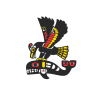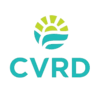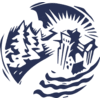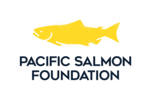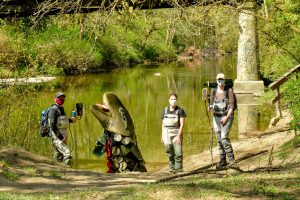
Twinned Watersheds Project. Setting up to measure water flows and salmon habitats as they change throughout the season. May 2021. Photo by Tricia Thomas, Salish Eye Productions
We want healthy, wild, and diverse fish populations in the Cowichan-Koksilah watershed.
Indicator
- An Indigenous Indicator reflecting indigenous knowledge/values is under development in consultation with Cowichan Tribes.
- Fish abundance in the Cowichan watershed meets or exceeds targets set by fisheries agencies. [Link needed here]
- Chinook, Chum and Steelhead escapement estimates are generated on an annual basis for the Koksilah River.
Rationale
Like many coastal BC watersheds, the Cowichan watershed is considered a salmon-driven ecosystem. The massive nutrient load that salmon bring back into the river and shorelines every year when they return from the ocean is akin to adding fertilizer to the garden. Many species feast on the nitrogen-rich fish, eggs, and carcasses, and then cycle those nutrients far upslope. So, protect the fish, and feed the forest.
The fish themselves are also an irreplaceable food and cultural resource for First Nations, an important driver for the recreation and tourism industry locally, and a big part of why the Cowichan is internationally renowned and recognized as a Canadian Heritage River.
The original indicator was "Salmon and steelhead pre-smolt abundance in the Cowichan watershed meets or exceeds target population densities set by DFO and FLNRORD." A juvenile salmonid indicator was chosen as a measure of watershed health acknowledging that watershed factors only dictate the success of the freshwater component of the salmon life history - we can’t control what happens at sea before the adult salmon return! If water quality, water quantity and riparian habitats are healthy enough to protect fish in their juvenile life stages in the watershed, and if there are enough eggs to hatch from returning salmon, then the species should be sustainable. Steelhead[1] were selected for the first target as they spend more time in the river than other types of salmon (up to three years instead of a few days or months for other species), so they are more influenced by watershed factors. Also, unlike chinook and other salmon, they are not targeted by fisheries in the marine environment so the number of adults returning more accurately reflects the health of the watershed.
 Progress
Progress
Progress on this target is closely linked to achievements in the related Flows target due to the inter-connectivity between these values (see Flows target profile for more information). Managing river flows is key to meeting this target to ensure adequate conditions for adult migration and spawning, to prevent eggs or alevins (larval salmon still in the gravel) from drying up and to provide enough water for juvenile rearing and downstream migration. These conditions are all supported by the work associated with the Flows target.
Coordinated habitat restoration work in the watershed from the lake tributaries to the estuary has contributed significantly to ensuring sustainable salmonid populations in the river. This whole-of-watershed approach to restoring habitat has recently been bolstered through a $2.7-million partnership between Cowichan Tribes and Fisheries and Oceans Canada. This work will include extensive riparian restoration in both the Cowichan and Koksilah watersheds, major restorative works in the Cowichan Estuary, and the development of a new approach to managing the Stoltz bluffs – a major source of sediment input to the Cowichan River that has been the focus of considerable community effort for over a decade.
As well, a Cowichan chinook rebuilding framework has been developed through extensive engagement of local experts, traditional knowledge and agency professionals. Finally, a coordinated, well-documented, targeted fry salvage program is implemented annually depending on need and opportunity to effectively re-distribute juveniles to suitable under-utilized habitats.
Monitoring
Steelhead juvenile densities are monitored annually by field crews resourced through a partnership between FLNRORD and the British Columbia Conservation Foundation, with the results being compared to guidelines developed by Provincial staff. As well, chinook salmon are closely monitored on the Cowichan through a partnership between DFO and Cowichan Tribes using a variety of tools including a counting fence, DIDSON sonar monitors, coded transponder tagging (called PIT tags), downstream trapping and a dead-pitch program. In fact, more effort goes into monitoring Cowichan chinook that any other salmon stock on Vancouver Island!
Next Steps
- Complete Cowichan River Water Use Plan (spring 2018)
- Identify a conservation water license holder for the weir at Cowichan Lake
- Secure funding to design and build a higher weir
- Create chinook salmon fisheries target
- Continue partnering with FLNRO on a flow monitoring regime and response for Koksilah River
- Continue to assess and improve salmon and steelhead monitoring programs on Cowichan and Koksilah Rivers
- Continue to implement and assess salmonid habitat restoration works in the Cowichan watershed
[1] Steelhead were considered an anadromous trout until about 10 years ago when they were re-classified as a pacific salmon.
Related Resources
Steelhead Fry Abundance-Fish Sustainability Target-Wightman-Jan2012
Flows-for-Fish-SDM-Report-Update-13Sep2017
FisheryOfficerTalk-withCWB-27Mar2017
Flows-and-FishWG-Principles-and-Vision-draft3
Cowichan River Flows Structured Decision Making ProcessFINALDRAFT June 23rd, 2017
CowichanSalmonOverview-WilfLuedke-07Jul2011
Hybrid salmon discovered - CBC Article Oct 12 2019
CowichanChinookKnowledge-Mar2013
CWB-ChinookProjectUpdate-C.Ayers-29Feb2016
CowchanChinookWorkshop-DFO-March2013
Cowichan-Chinook-DNA-and-Early-Run-Abundance-2015-Project-Overview
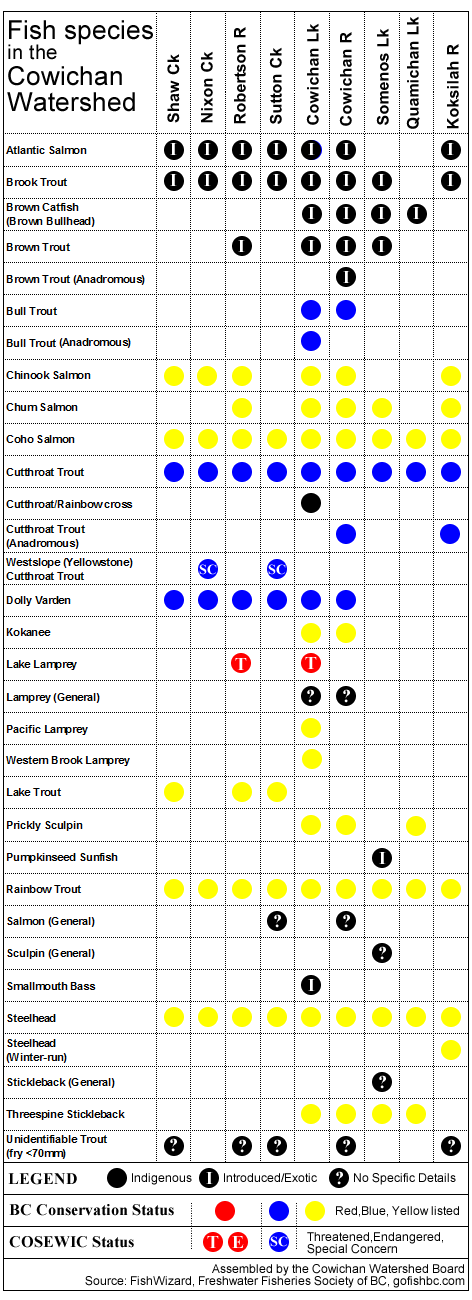 Progress
Progress Email
Email